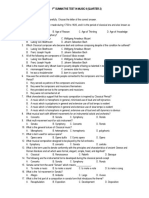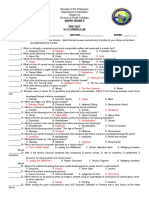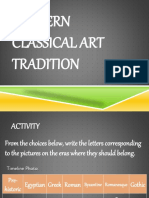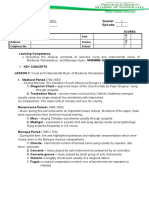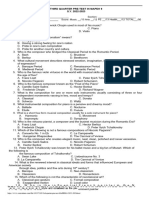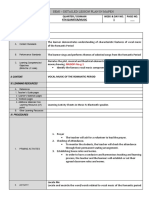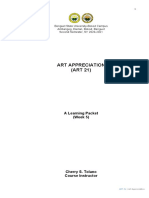0 ratings0% found this document useful (0 votes)
269 views(Grade 9) MAPEH (Arts) - Renaissance and Baroque Art
(Grade 9) MAPEH (Arts) - Renaissance and Baroque Art
Uploaded by
KenThis document provides an overview of Renaissance and Baroque art in Europe. It describes key characteristics of Renaissance art including accurate anatomy, scientific perspective, and emphasis on humanism. It profiles influential Renaissance artists like Michelangelo, Leonardo da Vinci, and Donatello. Baroque art is characterized by dramatic lighting, intense emotions, and illusion. The document briefly profiles Baroque artists like Caravaggio, Bernini, Rubens, and Rembrandt.
Copyright:
© All Rights Reserved
Available Formats
Download as DOCX, PDF, TXT or read online from Scribd
(Grade 9) MAPEH (Arts) - Renaissance and Baroque Art
(Grade 9) MAPEH (Arts) - Renaissance and Baroque Art
Uploaded by
Ken0 ratings0% found this document useful (0 votes)
269 views3 pagesThis document provides an overview of Renaissance and Baroque art in Europe. It describes key characteristics of Renaissance art including accurate anatomy, scientific perspective, and emphasis on humanism. It profiles influential Renaissance artists like Michelangelo, Leonardo da Vinci, and Donatello. Baroque art is characterized by dramatic lighting, intense emotions, and illusion. The document briefly profiles Baroque artists like Caravaggio, Bernini, Rubens, and Rembrandt.
Original Title
[Grade 9] MAPEH (Arts) - Renaissance and Baroque Art
Copyright
© © All Rights Reserved
Available Formats
DOCX, PDF, TXT or read online from Scribd
Share this document
Did you find this document useful?
Is this content inappropriate?
This document provides an overview of Renaissance and Baroque art in Europe. It describes key characteristics of Renaissance art including accurate anatomy, scientific perspective, and emphasis on humanism. It profiles influential Renaissance artists like Michelangelo, Leonardo da Vinci, and Donatello. Baroque art is characterized by dramatic lighting, intense emotions, and illusion. The document briefly profiles Baroque artists like Caravaggio, Bernini, Rubens, and Rembrandt.
Copyright:
© All Rights Reserved
Available Formats
Download as DOCX, PDF, TXT or read online from Scribd
Download as docx, pdf, or txt
0 ratings0% found this document useful (0 votes)
269 views3 pages(Grade 9) MAPEH (Arts) - Renaissance and Baroque Art
(Grade 9) MAPEH (Arts) - Renaissance and Baroque Art
Uploaded by
KenThis document provides an overview of Renaissance and Baroque art in Europe. It describes key characteristics of Renaissance art including accurate anatomy, scientific perspective, and emphasis on humanism. It profiles influential Renaissance artists like Michelangelo, Leonardo da Vinci, and Donatello. Baroque art is characterized by dramatic lighting, intense emotions, and illusion. The document briefly profiles Baroque artists like Caravaggio, Bernini, Rubens, and Rembrandt.
Copyright:
© All Rights Reserved
Available Formats
Download as DOCX, PDF, TXT or read online from Scribd
Download as docx, pdf, or txt
You are on page 1of 3
RENAISSANCE ART OF EUROPE -
He decorates the walls at the monastery
of the church of Santa Maria delle
RENAISSANCE Grazie in Milan, Italy.
Literally means “rebirth” - This piece features Jesus Christ in the
Period in Europe (14th – 17th century) center with his twelve disciples evenly
regarded as the cultural bridge between distributed on both his left and right.
middle age and modern history. MONA LISA (1503 – 1506)
- It is a portrait of Lisa Gherardini, the
Renaissance art was characterized by wife of Francesco del Giocondo
accurate anatomy (symmetry and balance), - Her calm gaze and mysterious smile
scientific perspective and deeper landscape. An have been the topic for many theorists.
intensified interest in Humanism and assertion
of the importance of the individual. RAFFAELLO SANZIO DA URBINO
(RAPHAEL) (1483 – 1520)
A revival of the classical forms originally Italian painter and architect
developed by the ancient Greeks and Romans. His work is admired through
As the classical Greeks believed in the interpreting the divine and incorporating
harmonious development of the person through Christian doctrines.
a sound mind by the practice of athletics. The Formed the trinity of great masters of
Renaissance held up the ideal of the well – that period.
rounded person, knowledgeable in a number of Artworks:
fields such as philosophy, science, arts including LA BELLE JARDINIERE
painting and music – and who applies his/her - It is one of most famous Madonna
knowledge to productive and creative activity. portraits of Italian Renaissance painter,
Raphael.
MICHELANGELO DI LODOVICO TRANSFIGURATION
BUONARROTI SIMONI (1475 – 1564) - Last painting which he worked on up to
Italian painter, sculptor, architect and his death.
poet. - Commissioned by Cardinal Giulo de
Considered to be the greatest living Medici (Late Pope Clement VII)
artist in his lifetime and one of the - Conceived as an altar piece for
greatest artist of all time. Narbonne Cathedral in France.
Artworks:
PIETA, (Sculpture) (1497 – 1500) DONATO DI NICCOLO DI BETTO BARDI
- It shows Christ in his mother’s lap, just (DONATELLO) (1386 – 1466)
after he is taken down from the cross. It Italian sculptor of Florence
is the portrayal of pain and redemption. Artworks:
THE CREATION OF ADAM (Fresco) MARY MAGDALEN (1454 – 1455)
- He placed a scene based on Genesis the - It shows the repentant Magdalene as a
first book of the Bible. He worked on haggard, old woman
high scaffolding as he painted the DAVID
ceiling of the Sistine Chapel. - It is the biblical hero “David” that is
LEONARDO DI SER PIERO DA VINCI made out of bronze and first known as
(1452 – 1519) free standing nude statue.
Italian painter, architect, scientist and
mathematician. What is the foundation of Western Art?
He was the quintessential Renaissance The rediscovery of Greco – Roman arts
man and considered to be one of the and sciences together with the Arabic
greatest painters of all time. knowledge of algebra and navigation was
Artworks: awakened when various city – states of Italy. Its
THE LAST SUPPER (1495 – 1497) ruler, Lorenzo de Medici, financed a huge
amount of money on research and projects Baroque sculpture, typically larger than
hiring scientists and artists in his speedy drive to life size, is marked by a similar sense of
augment European technology in catching up dynamic movement, along with an
with the advancement of the East. These city – active use of space.
states progressed rapidly – so much that the seat Baroque architecture was designed to
of learning revolved around these artists and create spectacle and illusion. Thus the
scientists. This is the revival of European lost straight lines of the Renaissance were
grandeur; this is Renaissance. replaced with flowing curves.
Renaissance Paintings The approaches of artists in applying the
Renaissance painting reflects the revival technique seem to vary according to the religion
of interest in classical culture and a strong belief which the particular artist professes: In between
in individualism. Works of Masaccio like the the Northern and Southern trends of Baroque
Expulsion from Paradise, the influence of style were the paintings of prominent
classical sculpture is shown on the pose of Eve personalities and the monarchies. In Protestant
whose arms attempt to cover her naked body. He Netherlands though, people from all walks of
is considered the pioneer of Renaissance life were included to appear as subjects of
painting. Other famous paintings produced portraiture.
during this period are “The Annunciation” by
Fra Angelico (c. 1400 – 55), “The Madonna of MICHANGELO MERISI or AMERIGHI DA
Chancellor Nicolas Rolin” by Jan van Eyck CARAVAGGIO (1571 – 1610)
(c. 1390 – 1441) and “The Birth of Venus” by Better known as Caravaggio
Botticelli (1445 – 1441) Outcast in the society because of his
Renaissance Sculpture own actions, lack of modesty and
Renaissance sculpture shows strong reverence for religious subject in his
interest in the ancient past. The work of own paintings.
Lorenzo Ghilberti where he cast two sets of Started out as a specialist in his
bronze doors for the Florence Baptistery is one paintings of still life (inanimate objects)
of the examples of Renaissance sculpture. These Models were either himself or young
bronze doors both demonstrate his knowledge of persons who have an air of being
ancient sculpture. promising but wicked.
Artworks:
BAROQUE ART OF EUROPE - SUPPER AT EMMAUS
- ENTOMBMENT OF CHRIST
BAROQUE - CONVERSATION OF ST. PAUL
Derived from the Portuguese word Painting on the story of Saul of Tarsus
“Barocco” which means “irregularly converted to an apostle of Christ.
shaped pearl or stone” The conversion on the road to Damascus
The Roman Catholic Church highly
encouraged the Baroque style to GIAN LORENZO BERNINI (1598 – 1680)
propagate Christianity while the Italian artist and first baroque artist
aristocracy used Baroque style for He practiced architecture and sculpture,
architecture and arts to impress visitors, painting, stage design, and was also a
express triumph, power and control. playwright
Baroque painting illustrated key Artworks were mostly religious
elements of Catholic dogma, either subjects, history paintings of magical
directly in Biblical works or indirectly creatures and hunt scenes.
in imaginary or symbolic work. The Artworks:
gestures are broader than Mannerist - THE GOAT AMALTHEA with the
gestures; less ambiguous, less arcane INFANT JUPITER and a FAUN
and mysterious.
- DAMNED SOUL and BLESSED Margaret Theresa, the eldest
SOUL daughter of the new Queen is
- PIZZA SAN PIETRO the subject of the painting.
- ECSTASY OF ST. TERESA
PETER PAUL RUBENS (1577 – 1640)
Flemish (Dutch/Belgian) Baroque
painter
Well – known for his paintings of
mythical and figurative subjects,
landscapes, portraits and Counter –
Reformation altarpieces.
Artworks:
- SAMSON AND DELILAH
- LANDSCAPE WITH A TOWER
- PORTRAIT OF HELENE
FOURMENT
- THE THREE GRACES
REMBRANDT HARMENSZOON VAN
RIJN (1606 – 1669)
Dutch realist, painter and etcher
Interested in spiritual values and often
chooses religious subjects
Rembrandt shares with Rubens the
revolution whereby painting came to
depict the more personal aspects of the
painter: his own home and his family.
Rembrandt had produced over 600
paintings, nearly 400 etchings, and 2000
drawings.
His well – known work was his “Self-
portrait in Old Age”
DIEGO VELASQUEZ (1599 – 1660)
One of the finest masters of composition
and one of the most important painters
of the Spanish Golden Age
The passion for still life frequently
emerges in Velasquez’s art.
Artworks:
- THE SURRENDER OF BREDA
- LOS BORACHOS
- MARIA THERESA
- LAS MENINAS
Created this work 4 years before
his death
Served as a European Baroque
period art
You might also like
- Guida Galleria SpadaDocument27 pagesGuida Galleria SpadaManuel PérezNo ratings yet
- Arts 9 Pivot - Activity Sheet: Learning Task 3: Observe The Artworks Carefully. Answer The Information Questions in YourDocument10 pagesArts 9 Pivot - Activity Sheet: Learning Task 3: Observe The Artworks Carefully. Answer The Information Questions in YourShaira Shane QuiniquitoNo ratings yet
- "Art of Renaissance and Baroque Period": Grade 9 - Arts Second QuarterDocument23 pages"Art of Renaissance and Baroque Period": Grade 9 - Arts Second QuarterAshley Rayne MacrohonNo ratings yet
- Arts Gr. 9 PPT LectureDocument22 pagesArts Gr. 9 PPT LectureARLENE SEVILLENANo ratings yet
- Q2 - Arts of The Renaissance Baroque PeriodDocument42 pagesQ2 - Arts of The Renaissance Baroque PeriodCarl Andrei AbellanosaNo ratings yet
- 1st Summative Test in Music 9 q2Document2 pages1st Summative Test in Music 9 q2ALICIA GONZALESNo ratings yet
- Art of Renaissance and Baroque PeriodDocument15 pagesArt of Renaissance and Baroque PeriodErvin John100% (1)
- Most of The Music of The Classical Era Is Known As The "Age of Reason or Age of Enlightenment". What AreDocument6 pagesMost of The Music of The Classical Era Is Known As The "Age of Reason or Age of Enlightenment". What AreJulie Ann SJ ClementeNo ratings yet
- Arts 9 - W 3 - Law - Q1Document4 pagesArts 9 - W 3 - Law - Q1Rechell Ann GulayNo ratings yet
- 3RD Finale Quarter Periodical Test in Mapeh 9Document8 pages3RD Finale Quarter Periodical Test in Mapeh 9MELVIN LAURONNo ratings yet
- Second-Periodical Test Mapeh-9Document6 pagesSecond-Periodical Test Mapeh-9Juvy Singian0% (1)
- Grade 9 - Quarter 3Document4 pagesGrade 9 - Quarter 3JC SabasNo ratings yet
- 3RD Music 1 Week Music of The Romantic Period PDFDocument50 pages3RD Music 1 Week Music of The Romantic Period PDFAmira TerminezNo ratings yet
- I. Multiple Choice: Write The Letter of The Correct Answer On The Space ProvidedDocument5 pagesI. Multiple Choice: Write The Letter of The Correct Answer On The Space Providedericson ricafortNo ratings yet
- Music 9: Learning Activity Sheet Music of The Classical PeriodDocument45 pagesMusic 9: Learning Activity Sheet Music of The Classical PeriodGabrielle TomoNo ratings yet
- Arts9 - q1 - Mod7 - Western Classical Art Traditions - v3Document12 pagesArts9 - q1 - Mod7 - Western Classical Art Traditions - v3Mark Jonest Balmocena Ferman0% (1)
- Las Art Q3 Week 1Document18 pagesLas Art Q3 Week 1juan martin arevaloNo ratings yet
- Mapeh 9Document3 pagesMapeh 9CHRISLYN JOYCE DIONANGANo ratings yet
- Learning Activity Sheet: ExploreDocument3 pagesLearning Activity Sheet: ExploreOdessa L. UrgelNo ratings yet
- Music 9 2nd QuarterDocument9 pagesMusic 9 2nd QuarterChristina Jarelle LosdocNo ratings yet
- THIRD QUATER ARTS Grade-9-MAPEH-Romanticism-ReportingDocument26 pagesTHIRD QUATER ARTS Grade-9-MAPEH-Romanticism-ReportingMark Anthony EsparzaNo ratings yet
- 1st-Summative-Test-in-MAPEH 9Document3 pages1st-Summative-Test-in-MAPEH 9John DiestroNo ratings yet
- Week 3: Second Quarter-Arts 9Document4 pagesWeek 3: Second Quarter-Arts 9Catherine Sagario OliquinoNo ratings yet
- Quarter 3 Module 1: Neoclassical Art: CO - Q3 - Arts9 - Module 1Document10 pagesQuarter 3 Module 1: Neoclassical Art: CO - Q3 - Arts9 - Module 1Diana Mae HombreNo ratings yet
- G9-Music-2nd-Quarter-Week-1 - 3Document9 pagesG9-Music-2nd-Quarter-Week-1 - 3Catherine Sagario OliquinoNo ratings yet
- First Grading Unit Test in Music 9: ScoreDocument2 pagesFirst Grading Unit Test in Music 9: ScoreDarey Daymiel ReyesNo ratings yet
- Arts of The Renaissance and Baroque PeriodsDocument22 pagesArts of The Renaissance and Baroque PeriodsKaren BlythNo ratings yet
- LAS MAPEH 9 Q3 W1 MusicDocument6 pagesLAS MAPEH 9 Q3 W1 MusicJemalyn Hibaya LasacaNo ratings yet
- Arts Activity Sheet: Quarter 2 - Week 1-2Document8 pagesArts Activity Sheet: Quarter 2 - Week 1-2Charrie Mae MalloNo ratings yet
- 9 Final Mapeh9 Pe q2 m1 Week 5Document14 pages9 Final Mapeh9 Pe q2 m1 Week 5Timothy Isaiah CastañedaNo ratings yet
- Western Arts Tradition ARTS 1Document31 pagesWestern Arts Tradition ARTS 1Krystine Joy Mandanas VillelaNo ratings yet
- Q3 PPT Arts9 Artist of Neoclassic and Romantic PeriodDocument28 pagesQ3 PPT Arts9 Artist of Neoclassic and Romantic PeriodALYSSA NICOLE GINESNo ratings yet
- Second Quarter Module 7-8: Week 6 Renaissance and Baroque Periods' Works of Art and InfluencesDocument25 pagesSecond Quarter Module 7-8: Week 6 Renaissance and Baroque Periods' Works of Art and Influencesh1danNo ratings yet
- 1st Diagnostic Test Mapeh 9Document3 pages1st Diagnostic Test Mapeh 9Bitemie TabilidNo ratings yet
- Mapeh 9 q3 Week 1Document10 pagesMapeh 9 q3 Week 1Reign BrilloNo ratings yet
- MAPEH 3rd QUARTER REVIEWERDocument3 pagesMAPEH 3rd QUARTER REVIEWERMatt Jazon T. ReyesNo ratings yet
- MAPEH 9 4th Quarter Week 1 8Document58 pagesMAPEH 9 4th Quarter Week 1 8Azel Ann Tiamzon100% (1)
- Grade 9 - Mapeh 2ND QuarterDocument8 pagesGrade 9 - Mapeh 2ND QuarterLeico Raieg B. SchuwardNo ratings yet
- Grade 7 MapehDocument2 pagesGrade 7 MapehJhie Manlogon100% (1)
- Arts 9 Q2 M1Document15 pagesArts 9 Q2 M1Manwa Lover100% (2)
- Music 4th QuarterDocument32 pagesMusic 4th Quartershiela manalaysayNo ratings yet
- I. True or False: Iloilo National High SchoolDocument2 pagesI. True or False: Iloilo National High SchoolVencint Karl TacardonNo ratings yet
- Long Quiz in Music III (First Grading)Document2 pagesLong Quiz in Music III (First Grading)MelaineRegisGenesisTorreaNo ratings yet
- Grade 9-Pe and Health 3RD QuarterDocument6 pagesGrade 9-Pe and Health 3RD QuarterJemar Cadion ArotaNo ratings yet
- Q1mapeh9 ReviewerDocument4 pagesQ1mapeh9 ReviewerAshley Nicole Vallespin100% (1)
- MAPEH 9 Q1-Week 1 (Music)Document3 pagesMAPEH 9 Q1-Week 1 (Music)KENT CLLOYD PONDOCNo ratings yet
- Las Mapeh 9 Q3 W3 PeDocument8 pagesLas Mapeh 9 Q3 W3 PeJemalyn Hibaya LasacaNo ratings yet
- G9 Arts 2ND Quarter Week 1 3Document9 pagesG9 Arts 2ND Quarter Week 1 3Catherine Sagario OliquinoNo ratings yet
- MUSIC 3rd PERIODIC TESTDocument2 pagesMUSIC 3rd PERIODIC TESTrachel0% (1)
- MUSICq3 Lesson 1Document13 pagesMUSICq3 Lesson 1Shelby Antonio50% (2)
- Diagnostic Test in Mapeh 10Document6 pagesDiagnostic Test in Mapeh 10Ronnel Andres HernandezNo ratings yet
- 2nd Quarter Summative Test in MAPEH 9 ......Document4 pages2nd Quarter Summative Test in MAPEH 9 ......koi100% (1)
- Arts 9 - Q2 - DW2Document5 pagesArts 9 - Q2 - DW2jubethNo ratings yet
- Q2 Mapeh 9 Exam 2022 2023Document2 pagesQ2 Mapeh 9 Exam 2022 2023Jasper LictawaNo ratings yet
- Western Classical Art Traditions (Report in Arts)Document3 pagesWestern Classical Art Traditions (Report in Arts)JanineP.DelaCruz0% (1)
- G9 Music LM Quarter 1 To 4Document140 pagesG9 Music LM Quarter 1 To 4Charlene BorladoNo ratings yet
- 3rd Quarter Pre Test MAPEH 9 2022 2023Document6 pages3rd Quarter Pre Test MAPEH 9 2022 2023ivy macalaladNo ratings yet
- q2 Music 9 Las Melc 2Document8 pagesq2 Music 9 Las Melc 2aleah kateNo ratings yet
- Festival Dances: Dances To Strong Beats of PercussionDocument26 pagesFestival Dances: Dances To Strong Beats of Percussionjohn lesterNo ratings yet
- LP 1 Music Q4 (05-03-2023)Document5 pagesLP 1 Music Q4 (05-03-2023)Hazel Rubas SamsonNo ratings yet
- Arts of The Renaissance and Baroque PeriodsDocument3 pagesArts of The Renaissance and Baroque PeriodsAiza Rhea SantosNo ratings yet
- (Grade 9) MAPEH (Music) - Music of The Classical Period (2nd)Document3 pages(Grade 9) MAPEH (Music) - Music of The Classical Period (2nd)Ken100% (1)
- (Grade 9) MAPEH (Health) - QuestionnaireDocument2 pages(Grade 9) MAPEH (Health) - QuestionnaireKenNo ratings yet
- (Grade 9) MAPEH (Health) - Drugs (2nd)Document3 pages(Grade 9) MAPEH (Health) - Drugs (2nd)KenNo ratings yet
- Ultimate Frisbee & Dodgeball: Physical Ed - Mapeh 9 ǀ Tutorial 2021 ǀ Online Class Season 2Document3 pagesUltimate Frisbee & Dodgeball: Physical Ed - Mapeh 9 ǀ Tutorial 2021 ǀ Online Class Season 2KenNo ratings yet
- Music of Medieval PeriodDocument2 pagesMusic of Medieval PeriodKenNo ratings yet
- Music of The Baroque Period: Music - Mapeh 9 ǀ Tutorial 2021 ǀ Online Class Season 2Document3 pagesMusic of The Baroque Period: Music - Mapeh 9 ǀ Tutorial 2021 ǀ Online Class Season 2KenNo ratings yet
- Music of Renaissance PeriodDocument2 pagesMusic of Renaissance PeriodKenNo ratings yet
- Architectural Reviewer All SubjectsDocument326 pagesArchitectural Reviewer All SubjectsTricia InfanteNo ratings yet
- Arts9 q1 Mod1 Western-classical-Arts v1Document26 pagesArts9 q1 Mod1 Western-classical-Arts v1Ivee Cruzette GarinNo ratings yet
- Module 14 Student Edition HistoryDocument32 pagesModule 14 Student Edition HistoryMarileth CaballeroNo ratings yet
- ArtMuseum WHITE Brochure FINAL WEBDocument11 pagesArtMuseum WHITE Brochure FINAL WEBalphaNo ratings yet
- OET B1 Progress Test Unit 9 A + BDocument8 pagesOET B1 Progress Test Unit 9 A + BЕлена ЛуцкаяNo ratings yet
- 3 Baroque 2Document12 pages3 Baroque 2Cory GledhillNo ratings yet
- William R. Corliss - Strange ArtifactsDocument271 pagesWilliam R. Corliss - Strange Artifactstosun666No ratings yet
- Oxford Art Online: Arnheim, RudolfDocument8 pagesOxford Art Online: Arnheim, Rudolfherac12No ratings yet
- Đề Thi Thử 11: Thpt Chuyên Long An Kỳ Thi Chọn Đội Tuyển Học Sinh Giỏi Quốc Gia Thpt Năm 2021 Môn: Tiếng AnhDocument18 pagesĐề Thi Thử 11: Thpt Chuyên Long An Kỳ Thi Chọn Đội Tuyển Học Sinh Giỏi Quốc Gia Thpt Năm 2021 Môn: Tiếng AnhThe EndNo ratings yet
- Grouping ArtsDocument5 pagesGrouping ArtsQuinn BitesNo ratings yet
- Matt Church Jake Cripwell Tom Lovell Toby Ning Avi SahaDocument20 pagesMatt Church Jake Cripwell Tom Lovell Toby Ning Avi SahaGrant_Miles91No ratings yet
- Practice Test F - Reading: Questions 1 - 10Document13 pagesPractice Test F - Reading: Questions 1 - 10Thụy ĐỗNo ratings yet
- Creative DramaDocument8 pagesCreative Dramasarang kmmnskNo ratings yet
- Understanding of Visual Arts in Relation To History and CultureDocument2 pagesUnderstanding of Visual Arts in Relation To History and Culturegarciapeng4No ratings yet
- Art Appreciation (ART 21) : A Learning Packet (Week 5)Document7 pagesArt Appreciation (ART 21) : A Learning Packet (Week 5)Glenda ElioNo ratings yet
- NMA Course GuideDocument27 pagesNMA Course GuidearyusyafwaneduNo ratings yet
- CART - Art AppreciationDocument1 pageCART - Art AppreciationCassiopoeia SaiNo ratings yet
- I Ethiopian Art and Visual Culture UoGDocument50 pagesI Ethiopian Art and Visual Culture UoGGedi BNo ratings yet
- Comparative Analysis of Two Works of ArtDocument6 pagesComparative Analysis of Two Works of Artkimanid488No ratings yet
- 04 Philippine Contemporary Art Forms From The Regionsq3 Wk3Document19 pages04 Philippine Contemporary Art Forms From The Regionsq3 Wk3kuramatsuga344No ratings yet
- De Thi Thu Dai HocDocument7 pagesDe Thi Thu Dai HocNhật Mai0% (1)
- Art Appreciation HS HomeschoolDocument5 pagesArt Appreciation HS HomeschoolRene Jay-ar Morante SegundoNo ratings yet
- Chaucer in Canterbury Sculpture ProjectDocument19 pagesChaucer in Canterbury Sculpture ProjectarrowtheponyNo ratings yet
- Lawton, F, Life Work of August Rodin, 1906Document472 pagesLawton, F, Life Work of August Rodin, 1906Emanuela Leite FragosoNo ratings yet
- Glass CastingDocument6 pagesGlass Castingsujit kcNo ratings yet
- Painting Sculptures and ArchitecturesDocument3 pagesPainting Sculptures and ArchitecturesRolandNo ratings yet
- The Gates of HellDocument3 pagesThe Gates of HelltasbeahNo ratings yet
- Moonlight Sculpter Volume 25Document245 pagesMoonlight Sculpter Volume 25Den Mark AlbayNo ratings yet
- Chennai White Marble - Kishangarh Marble - A Marble MandiDocument7 pagesChennai White Marble - Kishangarh Marble - A Marble MandiUthayakumar LakshmananNo ratings yet





